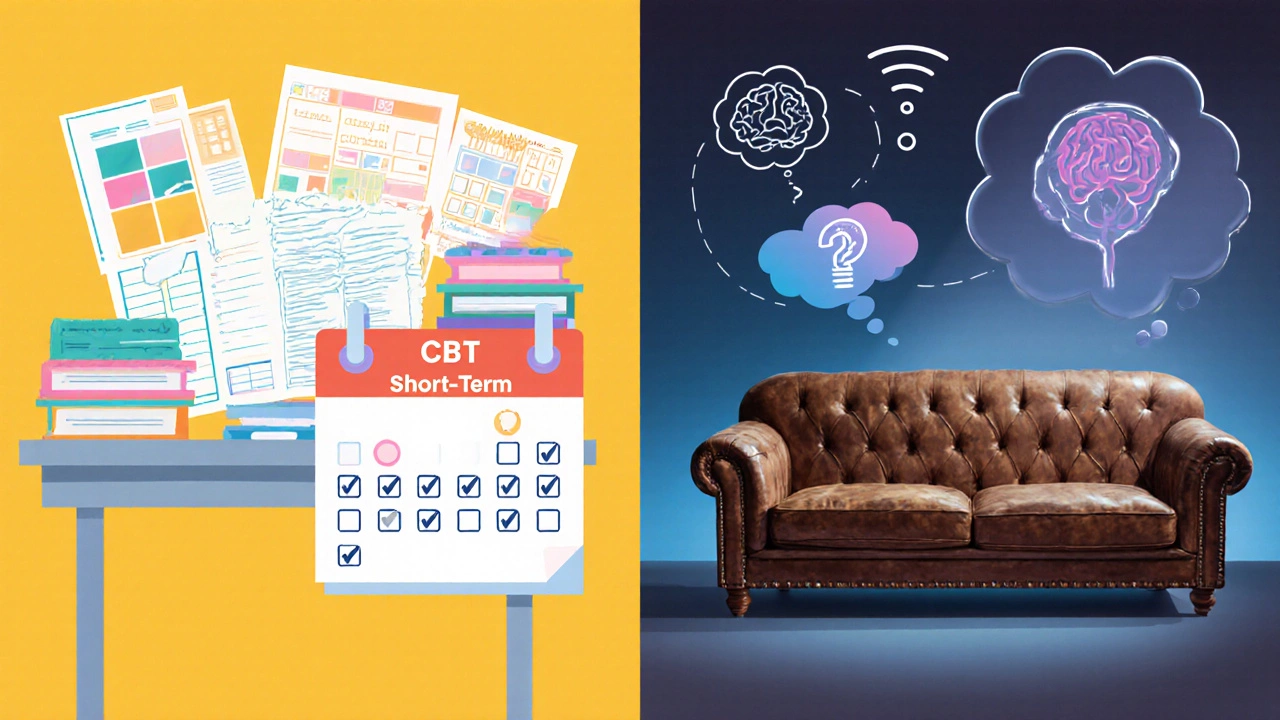Three years in a therapist’s chair feels like a lifetime to many, yet a lot of people stay in therapy for much longer. The big question is: is three years too long for therapy? The answer isn’t a simple yes or no- it depends on your goals, the type of work you’re doing, and how you feel about progress.
Quick Takeaways
- Therapy length varies widely; there’s no universal “right” number of sessions.
- Short‑term approaches (e.g., CBT) often last 12‑20 weeks, while deeper work (e.g., psychodynamic) can span years.
- Key indicators to consider ending therapy: stable mood, achieved goals, diminishing returns, and readiness for self‑management.
- Regular check‑ins with your therapist about goals and timeline keep the process transparent.
- If you feel stuck, explore adjuncts like group work, mindfulness, or a fresh therapeutic modality.
What Do We Mean by “Therapy Duration”?
Therapy is a structured process where a trained professional helps a client explore thoughts, feelings, and behaviors to improve mental well‑being. It can be delivered as psychotherapy, which specifically targets emotional and psychological challenges.
Unlike medication, which often has a clear prescription length, therapy is flexible. Some people sign up for a quick “crash course” to tackle a specific issue, while others embark on an ongoing journey of self‑discovery.
Factors That Influence How Long You Might Stay in Therapy
Several variables shape the timeline:
- Therapeutic modality: Cognitive Behavioral Therapy (CBT) typically follows a time‑limited protocol, often 12‑20 weekly sessions. In contrast, psychodynamic therapy delves into unconscious patterns and may continue for several years.
- Issue severity: Chronic conditions like major depression or complex trauma often need longer treatment than a situational anxiety spike.
- Goals set at the start: Some clients aim for symptom relief, others for personality restructuring or life‑transition support.
- Therapeutic alliance: The strength of the relationship between therapist and client, known as the therapeutic alliance, predicts how quickly progress can happen.
- External support: Access to community resources, medication, or supportive family can shorten or lengthen the journey.
Pros and Cons of Long‑Term Therapy
Sticking with a therapist for three years or more has clear advantages and drawbacks.
- Pros
- Deep, lasting change: Long‑term work can rewire core beliefs and relational patterns.
- Consistent support during life transitions (career change, divorce, parenting).
- Opportunity to explore subconscious material that short‑term models skim over.
- Cons
- Risk of dependency if the client relies too heavily on the therapist for decision‑making.
- Higher financial cost and time commitment.
- Potential for stagnation if goals aren’t revisited regularly.

When Might It Be Time to End Therapy?
There’s no magic number, but certain signs suggest you’ve harvested most of the benefits:
- You've met or exceeded the treatment plan goals you set at the beginning.
- Daily functioning feels stable- you can manage stress, relationships, and work without frequent crisis calls.
- Progress charts (mood logs, anxiety scores) show a flat or upward trend over several months.
- You feel confident applying coping skills independently.
- Both you and your therapist notice diminishing new insights.
If you’re ticking most of these boxes, bring up a “termination discussion” in your next session. A good therapist will help you create a tapering plan, perhaps shifting to monthly check‑ins.
Alternatives or Adjuncts to Consider
Feeling stuck after a few years doesn’t mean you’ve failed. Instead, think of other tools that can complement or replace ongoing one‑on‑one sessions.
- Group therapy: Offers peer support and diverse perspectives at a lower cost.
- Mindfulness‑based stress reduction (MBSR): Provides self‑regulation techniques you can practice daily.
- Medication review: A psychiatrist can assess whether a short‑term medication boost might accelerate progress.
- Coaching or life‑skills workshops: Focuses on goal‑setting and pragmatic planning rather than deep emotional work.
How to Talk About Duration With Your Therapist
Open communication is the cornerstone of a healthy alliance. Use these simple steps:
- Schedule a dedicated session to review your treatment plan.
- Bring data: mood charts, journal excerpts, or any metrics you’ve tracked.
- Ask direct questions: “Do you see any new goals we should add?” or “Is there a point where we could start tapering sessions?”
- Discuss feelings about ending: fear of losing support is normal and worth exploring.
- Agree on a clear timeline or a set of criteria for transitioning out.
Short‑Term vs Long‑Term Therapy: A Quick Comparison
| Aspect | Short‑Term (≤6 months) | Long‑Term (≥1 year) |
|---|---|---|
| Typical Modalities | CBT, Solution‑Focused Brief Therapy, EMDR (focused) | Psychodynamic, Person‑Centred, Schema Therapy |
| Primary Goal | Symptom relief, skill acquisition | Deep personality change, relational patterns |
| Frequency | Weekly or bi‑weekly | Weekly to monthly, often adjusts over time |
| Typical Cost (UK) | £40‑£80 per session | £60‑£120 per session (often longer overall) |
| Risk of Dependency | Low to moderate | Higher; requires clear termination planning |

Checklist: Evaluating Whether to Continue Therapy
- Have you documented progress over the last 3‑6 months?
- Do you still have unmet, specific goals?
- Are you feeling financially comfortable with the schedule?
- Is the therapeutic relationship still supportive and challenging?
- Do you have alternative coping tools that work without weekly sessions?
- Would a different modality (e.g., group, coaching) address your needs better?
Real‑World Example: Sarah’s Three‑Year Journey
Sarah started therapy in 2021 after a painful divorce. She began with CBT to manage panic attacks, then shifted to psychodynamic work to explore attachment wounds. By 2024, her anxiety scores dropped from 18/21 to 4/21, and she reported better relationship patterns. However, she still felt a lingering sense of self‑doubt during major career moves.
When Sarah asked, “Is three years too long?” her therapist suggested a phased transition: reduce sessions to monthly, join a women’s support group, and start a mindfulness course. Six months later, Sarah felt empowered to handle new challenges without weekly visits, proving that the timeline itself isn’t the issue- it’s the purposeful evolution of support.
Bottom Line
Three years isn’t inherently “too long.” It’s only too long if you’re not gaining new value, if costs outweigh benefits, or if you’re avoiding other growth opportunities. Regularly revisit your goals, track measurable progress, and keep an honest dialogue with your therapist. When the signs point toward stability and self‑reliance, it’s a healthy cue to start planning your next chapter-whether that means tapering, switching modalities, or stepping into self‑directed practice.
Frequently Asked Questions
How many therapy sessions are typical for anxiety?
For moderate anxiety, a CBT protocol often spans 12‑20 weekly sessions. More chronic anxiety may need longer, but progress should be reviewed every 3‑4 months.
Can I take a break from therapy and come back later?
Yes. Many clients pause for a few months to apply skills independently, then return for a “check‑in” or to address new issues. Discuss a break plan with your therapist in advance.
What’s the difference between therapy and counseling?
Therapy (or psychotherapy) usually explores deeper emotional patterns and unconscious processes, while counseling often focuses on specific problems like career advice or stress management.
Is it normal to feel scared about ending therapy?
Absolutely. The therapeutic relationship can feel like a safe harbor, so fear of loss is common. Exploring that fear can actually become a final growth opportunity.
How does the NHS handle long‑term therapy?
The NHS mental health services offer a stepped‑care model. Initial assessments may lead to 6‑12 weekly sessions, after which a review decides whether a longer course, a different modality, or community support is needed.





